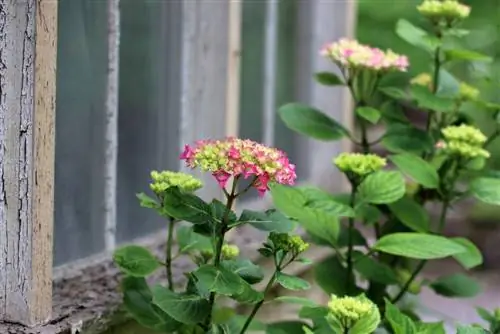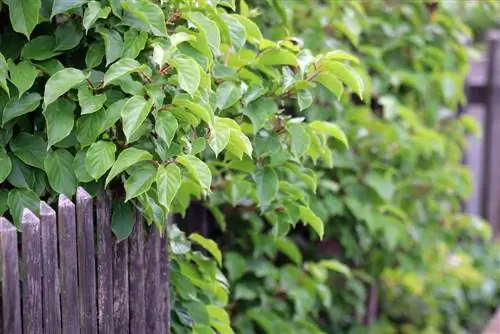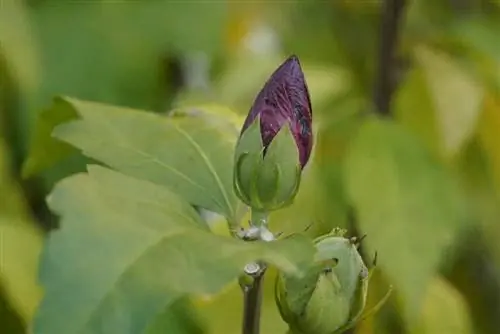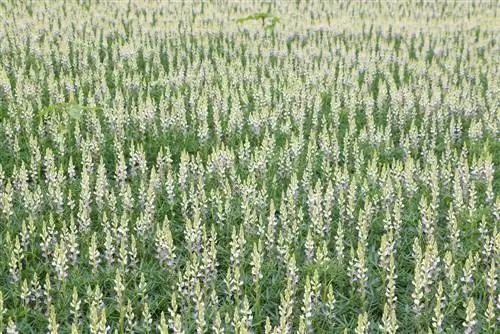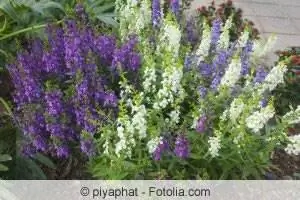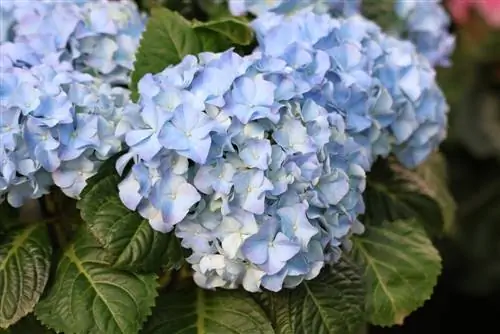- Author admin [email protected].
- Public 2023-12-17 03:39.
- Last modified 2025-01-24 12:45.
When you think of hydrangeas, you usually immediately see their lush, flower-filled umbels in your mind's eye. They are something like the trademark of this rather undemanding plant. Above all, they are a true splendor in any ornamental garden. So it's no wonder that the garden hydrangea has experienced a renaissance in recent years. The fact that it is extremely easy to care for may also have helped.
Farmer Hydrangea
When people talk about hydrangeas in this country, it is usually about Hydrangea macrophylla, the farmer's or garden hydrangea. Both names have become common in German, but they always refer to the same plant species. The farmer's hydrangea can be cultivated both in a pot and directly outdoors and reaches a size of up to two meters. From June to October it produces extremely large umbels of flowers. The petals are usually blue, purple, pink, red or white. There are now a whole range of varieties available from specialist retailers. The four most popular and widely used are:
- Alpenglow
- Endless Summer
- Masja
- Tovelit
Tip:
If you want to enjoy the flowers of the hydrangea all summer long, it is best to choose the Endless Summer variety. It blooms several times and actually lasts a summer.
Planting time
The ideal planting time for garden hydrangeas is late spring. It is best to plant them after the so-called Ice Saints in mid-May. In any case, it should be ensured that no more night frosts are to be expected. On the other hand, it is advisable not to wait too long so that the roots have enough time to grow before the first frost comes in autumn. The hydrangea should be in the ground outside in the garden by the end of July at the latest.
Location
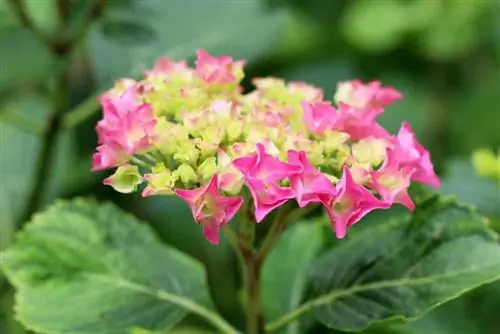
The right location is half the battle with hydrangeas. The plants like partial shade and protection. Under no circumstances should they be exposed to direct sunlight. Of course, this especially applies to the particularly strong midday sun. It is ideal to plant garden hydrangeas below and in the immediate vicinity of higher-growing trees. These provide shade and protect the sensitive hydrangea flowers from the wind. A location in the immediate vicinity of a house wall is also possible if it is not on the sunny side. Once again: Like all plants, garden hydrangeas also need light. However, if there is too much sun, they burn very quickly. That's why you should definitely make sure there is enough shade.
Floor
Soil conditions are at least as important as the location for hydrangeas to thrive. The soil should definitely be loose and very rich in humus and nutrients. If it is also slightly acidic, the plant will feel good later without any ifs or buts. In principle, it can also cope with alkaline soils, but a pH value of 7.5 must not be exceeded. A pH value that is too high can cause so-called chlorosis in all types of hydrangeas, which in turn causes the leaves to turn yellow and die. If you have any doubts about the pH value of the soil, it is best to measure it with a test strip, which is available from specialist retailers. It is also important that the soil contains no or very little clay. Good water drainage must be guaranteed.
Planting
Planting the garden hydrangea outdoors basically starts before you put the spade in place. It is strongly recommended to water the plant well beforehand. Then proceed as follows:
- Use a spade to dig a planting hole that is at least twice as large as the root ball
- mix the excavated soil with compost and thoroughly loosen the soil in the planting hole
- create a layer of gravel at the bottom of the planting hole to avoid waterlogging later, and then add some excavation to this layer
- then place the plant in the planting hole so that the top of the root ball is flush with the soil surface if possible
- then fill the remaining excavation into the trough and press it down well
Tip:
The hydrangea should be watered thoroughly immediately after planting. It can also make sense to create a so-called watering edge around the plant. This helps ensure that the water actually reaches the roots and doesn't run away to nowhere.
Care
As already mentioned, the farmer's or garden hydrangea is relatively undemanding and very easy to care for. The most important thing is to water them regularly. Hydrangeas like it moist and require a lot of water. At the same time, waterlogging must be avoided at all costs, as this would cause the roots to rot. A slightly moist soil around the plant is ideal. Under no circumstances should the soil dry out.
In addition to water, the hydrangea also needs regular fertilizer during the summer months. Organic liquid fertilizer is best suited for this and is added directly to the irrigation water. Fertilization should continue in the summer until the growth phase has ended. This is usually the case at the end of August. The garden hydrangea does not necessarily have to be cut or cut back. It is sufficient to remove dead shoots in spring.
Container cultivation
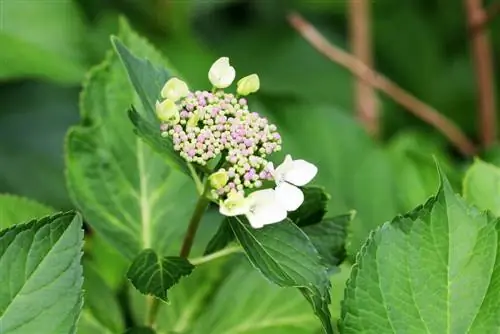
If you don't have a garden or don't have the right location for the farmer's hydrangea in your own garden, you can also cultivate it in a planter. Important: The bucket must be sufficiently large. It should be twice the size of the root ball. In addition, a drainage layer made of expanded clay or clay shards should be created. Commercially available potting soil is suitable as a substrate and can be enriched with a little humus. Otherwise, the care instructions for outdoor cultivation apply.
Tip:
Hydrangeas in pots should be placed on the terrace or balcony in partial shade during the summer months.
Wintering
Basically, the garden hydrangea is hardy. It can therefore remain in the ground even when there is ice and snow. However, it is advisable to protect them from severe frost with at least some leaves or plant fleece. This is especially true for young plants in the first year after planting. Farm hydrangeas in pots are moved to a cool and dry room in the fall to overwinter, where they remain until May of the following year. The hydrangea needs to be watered regularly. However, you should take into account that the plant naturally needs significantly less water in winter than in summer. Of course, the soil must not dry out during this phase.
Diseases and pests
All types of hydrangeas are extremely robust and resilient. They prove to be largely immune to diseases and pest infestations. However, both are of course not completely ruled out. Can occur:
- powdery mildew
- Chlorosis
- Scale insects
- Spider mites
If you are infected with powdery mildew, only treatment with a special pesticide helps. If there is chlorosis, the soil must be checked and, if necessary, the pH value must be lowered with peat. Scale insects and spider mites are very rare in farmer's hydrangeas. If so, treatment with a specific pesticide is recommended.
Propagation
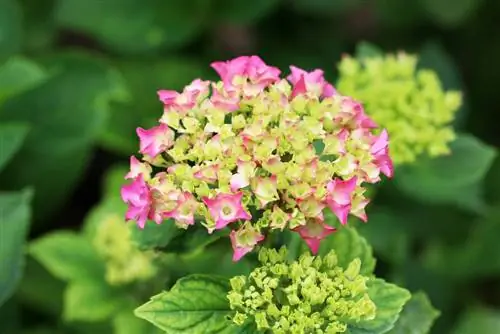
Garden hydrangeas are extremely easy to propagate. Propagation occurs via so-called head cuttings. To do this, simply cut off shoot tips that are no more than 15 centimeters long using sharp secateurs or a sharp knife. The best time for this is June or July. The shoot tips may have leaves, but no buds. When propagating, proceed as follows:
- Reduce the number of sheets by half
- then simply place the cutting in nutrient-poor substrate in a planter
- Put a transparent plastic bag over it to create a greenhouse atmosphere
- then move the whole thing to a bright location
- keep the soil evenly moist at all times
Under normal circumstances, the cuttings will develop roots after just a few weeks. Once this is done, transplant into a larger planter.
Blue color
Blue is an extremely popular color for garden hydrangeas. However, this plant does not naturally have any blue flowers. Their blue color has more to do with the composition of the soil. So it is only created in the garden. However, this only works with varieties that normally produce pink flowers. With white and red flowers, however, every effort is in vain. To obtain blue flowers, the soil must be acidic and contain aluminum.
A pH value of 4.0 to 4.5 is ideal. If the existing soil does not reach these values, you can add special rhododendron soil to the planting hole that is exactly in the required acidic spectrum. Aluminum, in turn, must be supplied to the soil externally. Either you use a blue dye or potassium alum. Both are available at the pharmacy. It is also important that the plant is then only watered with rainwater. It takes a while for the blue color to appear. It usually only becomes fully developed in the second year. However, it's worth the wait.

